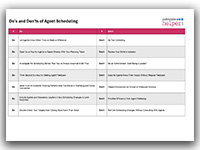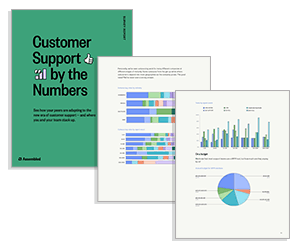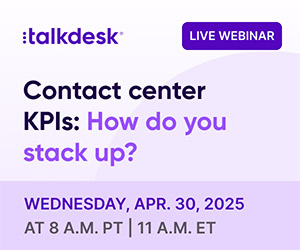Agent scheduling impacts every aspect of contact centre life, from meeting service levels and achieving high customer satisfaction scores, to maintaining employee engagement and reducing attrition. So how do you get it right?
Perfection is impossible, but there are plenty of things you can do to improve. That’s why our Editor, Megan Jones, spoke to Alec Bowman-Clarke, Bryce Ackerman, and Phil Anderson about the underlying principles of great agent scheduling.
DO: Let Agents Know When They’ve Made a Difference
When asking agents to make a change to their scheduled shifts to help meet service levels, follow up wherever possible to let them know the positive impact it’s had.

“Agents are typically happy to be flexible and take a lot of pride in it, so when the planning team says to them, ‘Would you mind working late on Friday?’, or ‘Could you do this Sunday instead of next Sunday?’ they say, ‘Yes, I can help with that.’
However, when they make the change, only to sit on a quiet shift and never hear if it made a positive difference or not, goodwill can quickly sour!
I know it’s not practical to do this every single time you switch someone’s shift around, but if you’re asking people to make a change, then tell them how it helped!
Even if it’s just an all-team update to say, ‘We achieved [insert results] because of your efforts and flexibility last week. Thank you!’ Agents just really love to know they helped, so be sure to close the loop with them!” – Alec Bowman-Clarke, WFO Consultant at Darling Solutions Ltd
DO: Open Up a Way for Agents to Speak Directly With Your Planning Team
Communication with the planning team shouldn’t be for the first-day induction only! Instead, make sure agents know where to come and find you if they have any questions throughout their employment.

“Don’t meet new hires for 45 minutes, explain WFM (which they will retain 25% of) then say, ‘If you have any questions from now on, talk to your lead or supervisor.’
In their minds, the Scheduler is either 1) too busy for them or 2) the agents aren’t important enough. Though challenging, open up a way for agents to speak directly with your team.” – Bryce Ackerman, Workforce Management Internal Consultant at Roche
DON’T: Be Too Controlling
When looking to improve your agent scheduling, stop to ask yourself – Am I too controlling?
A good way to determine this is to consider what happens when an agent needs to book a doctor’s appointment.
Are you controlling and expecting them to come to you and get permission to book the appointment, or flexible enough to give them the freedom to book the appointment they need and help sort it out later?
“Planners, at their very worst, try to restrict, limit, and control something that is so dynamic and ever-changing that it doesn’t do anyone any good.
So don’t manage any flexible working policy by the 2% of the population of your contact centre who are typically hard work and might not be there in five months, let alone five years!” – Phil Anderson, Chief Executive Officer at The Forum
DO: Investigate the Scheduling Stories That You’ve Always Assumed to Be True
Investigate the scheduling stories that you’ve always assumed to be true!
“Certain stories have always stuck, such as stay-at-home mums love split schedules, and students prefer working night shifts, but are they true? Ask your agents and find out! Don’t just make assumptions!” – Bryce Ackerman
DON’T: Review Your Shifts in Isolation
Don’t ever review your available shift patterns in isolation!
You need to do this against the backdrop of the forecast, handling times, technology, customer journeys, and employee experience to be truly effective.
Also be sure to look at absences, sickness, and holidays because they’re all interconnected!
If you do have an absence problem you want to fix, read our article: Need to Reduce Absence in Your Contact Centre? Here’s How!
DO: Think Beyond Surveys for Getting Agent Feedback
When trying to gauge your agents’ opinions on your current scheduling practices, find a better way to get feedback than just surveys!
“Surveys are easy to send out, but most people don’t fill them out, so who’s to say your agents will? Also be conscious if there a history of surveys that went nowhere.
Have agents been surveyed before and nothing came from it? If so, that will make it even more challenging to get honest responses.” – Bryce Ackerman
A sure-fire way to get honest opinions is to invest time in talking to your agents.
“Recently, I sat down with 350 frontline agents from a large UK-based contact centre. In groups of 10, they took an hour off from their work to come and sit in a room and discuss their scheduling experiences with me.
It was hard work, but such a valuable experience to give them a voice and hear what they had to say.” – Alec Bowman-Clarke
DO: Make Sure All Available Working Patterns Also Contribute to Wellbeing and Social Connection
Another scheduling consideration is to ensure that all available working patterns contribute not only to contact centre performance, but also to an individual’s wellbeing and social connection.
“In the worst examples, working shorter shifts can isolate individuals. They might perform well enough, but they’re misaligned with the rest of the team – missing out on sharing their knowledge, getting chances to spend time with their colleagues, and even missing out on opportunities to learn from their team leader in daily huddles – all of which can negatively impact their long-term performance and engagement.” – Phil Anderson
It’s about being aware of unintended consequences of part-time and flexible working options and trying to balance the situation in everyone’s best interests.
DO: Include Agents and Operations Leaders in Any Scheduling Changes to Limit Surprises
When making scheduling changes, be sure to include agents and operations leaders from the very beginning to limit surprises.
“Just as you’d like to be included in the Operational Strategy from the beginning, this approach improves communication, understanding, and buy-in. Humans like to feel needed and a part of something.” – Bryce Ackerman
Is your current scheduling process having a negative impact on agents and customers alike? Then read our article: Is Your Scheduling in Need of an Overhaul? Try These 8 Top Tips
DO: Double-Check Your Targets Aren’t Doing More Harm Than Good
Don’t set targets around schedule fit or productivity, because there are so many variables that could impact it.
“You could create an unbelievable working strategy, but still miss your targets. Likewise, you could achieve quite high scores and have created the worst set of schedules anyone’s ever seen.
Yes, identify opportunities for improvement, but never set them as a target because that’s just the wrong thing to do.” – Phil Anderson
That being said, if you are setting your agents targets (against adherence, for example) make sure to let them know how they are performing against them!
“Agents often like the idea of having targets and visibility of their individual performance so they know how they are doing, but this approach can quickly fall down if they only hear about their performance at their six-monthly review.
For many, that’s actually worse than just not measuring them at all because it’s really demotivating if they feel like you don’t care enough to even bother making the report. Quite simply, don’t have a measurement at all if you can’t stand by it and produce a report!” – Alec Bowman-Clarke
DON’T: Be an Administrator, Start Being a Leader!
The worst planners are those who end up becoming administrators, spending their time going through an inbox, completing tasks, and trying to make small improvements here and there.

“What shifts the dial from an ‘administrator of shifts’ to a ‘leader’ is the ability to analyse and draw out understanding of what’s happened in the past to try and improve what’s going to happen next – with a clear focus on ensuring you’ve got the right people in the right place with the right skills.
You’ve got to look at agent scheduling as a piece of a jigsaw, supporting your culture and business strategy. It shouldn’t just be a one-off review either, it should be a constant improvement process.” – Phil Anderson
Want to brush up on your leadership skills? Then read our article: Team Leadership: What Makes a Great Leader?
Printable – Dos and Don’ts of Agent Scheduling
We’ve created an easy printable for your contact centre! Do you want to download this to give to your team?
Get your free download of the Do’s and Don’ts of Agent Scheduling now:
What’s Been Your Experience of Agent Scheduling? What Dos and Don’ts Are on Your List?
Join our LinkedIn community and share your thoughts.
With thanks to the following people for sharing their thoughts and experiences for this article:
- Alec Bowman-Clarke, WFO / WEM / WFE Consultant at Darling Solutions Ltd
- Bryce Ackerman, Workforce Management Internal Consultant at Roche
- Phil Anderson, Chief Executive Officer at The Forum
If you are looking for more information on contact centre scheduling and staffing, read these articles next:
- How to Change Your Shift Patterns – Without Losing Your Best Agents!
- The Top Scheduling Challenges and How to Fix Them
- Using Scheduling Playbooks to Manage Spikes in Service Demand
Author: Megan Jones
Reviewed by: Xander Freeman
Published On: 11th Feb 2025 - Last modified: 12th Feb 2025
Read more about - Workforce Planning, Alec Bowman-Clarke, Bryce Ackerman, Phil Anderson, Scheduling, Staffing, Top Story, Workforce Management (WFM)






































